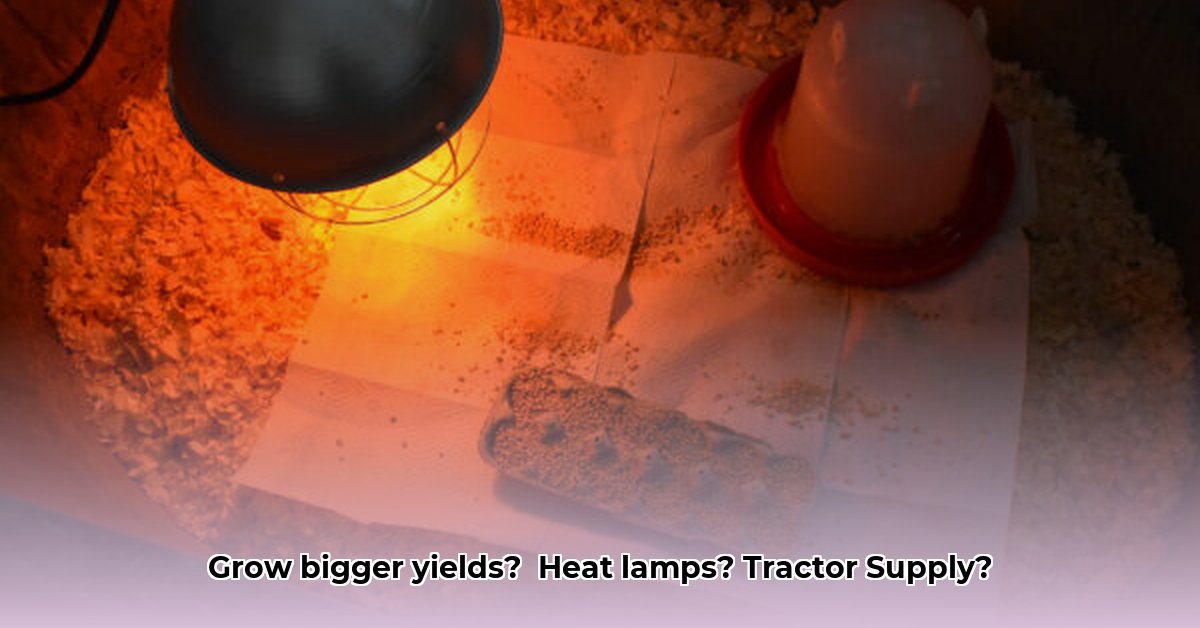
Heat Lamp Bulbs: Choosing the Right One for Your Needs
Selecting the correct heat lamp bulb from Tractor Supply can significantly impact your yields and energy costs. The first step is understanding the differences between bulb types and choosing the wattage appropriate for your application. Don't just grab the first bulb you see; understanding your needs will guide you to the most efficient and effective choice. For raising chicks, remember to consider chick brooder needs; you might find helpful information on chick costs at Tractor Supply.
Understanding Wattage and Bulb Types
Wattage determines the heat output. Higher wattage means more heat, but also higher energy consumption. Consider the size of the area and the sensitivity of your plants or animals. A small chick brooder requires far less wattage than a large calf pen.
Tractor Supply offers several bulb types:
Incandescent: These provide instant heat but are energy-intensive and short-lived. Think of them as the "fast food" of heat lamps—quick and satisfying, but not the most sustainable. They are best suited for small, short-term applications.
Infrared (IR): IR bulbs are significantly more energy-efficient with a longer lifespan. They offer a "slow-cooker" approach to heating—gradual and consistent warmth over time. They are ideal for larger spaces and longer-term usage.
Halogen: Halogen bulbs offer a balance between these two extremes, providing a good compromise between heat output, lifespan, and energy efficiency. They're a good middle ground for many applications.
Which type is best for you? A small brooding box might benefit from an incandescent bulb due to its instant heat. However, for long-term use, and to maximize energy savings and bulb life, infrared remains the top choice. Halogen bulbs offer a practical option somewhere in between.
Bulb Type Comparison
| Bulb Type | Pros | Cons | Best Use |
|---|---|---|---|
| Incandescent | Instant heat, readily available, inexpensive upfront | High energy use, short lifespan, safety concerns (heat) | Short-term use, small areas, quick warming needs |
| Infrared | Energy-efficient, long lifespan, safer to handle | Slower warm-up time | Long-term use, larger spaces, energy savings a priority |
| Halogen | Good balance of heat, lifespan, and energy efficiency | More expensive upfront | Moderate-sized areas, balancing cost and efficiency |
Safe Installation and Use: A Step-by-Step Guide
Safety is paramount when using heat lamps. Always follow the manufacturer’s instructions and these safety guidelines:
Choose the Right Fixture: Select a fixture rated for the wattage of your chosen bulb. Avoid overloading circuits. A properly rated fixture also enhances safety.
Secure Mounting: Mount the fixture securely, away from flammable materials like hay or straw, and out of reach of animals. Improper mounting is a leading cause of heat lamp accidents.
Ensure Proper Ventilation: Heat lamps generate significant heat. Adequate ventilation prevents overheating and fire hazards. Good airflow is essential.
Regular Inspection: Regularly inspect cords, sockets, and the bulb for damage. Replace damaged components immediately. Don't risk a fire.
Never Leave Unattended: Never leave a heat lamp unattended, particularly around animals or plants. This precaution is critical for safety.
Heat Lamp Applications on Your Farm
Beyond simply keeping livestock warm, heat lamps offer versatile applications:
Livestock and Poultry: Supplemental warmth significantly improves survival rates for young animals and promotes faster growth.
Seedling Protection: In greenhouses or nurseries, heat lamps encourage seedling growth, especially during colder periods. This extends the growing season.
Water Trough Protection: In freezing conditions, heat lamps prevent water troughs from freezing, ensuring constant access to water for livestock.
Birthing Assistance: In some cases, heat lamps provide supplemental warmth to support birthing processes.
These are just a few examples of heat lamp applications, and their versatility makes them a valuable tool for many farm operations.
Optimizing Heat Lamp Placement and Maintenance
Proper placement and regular maintenance are essential for maximizing effectiveness and safety:
Proper Distance: Maintain a safe distance to prevent burns. Find the ideal distance through experimentation.
Airflow: Ensure adequate airflow around the lamp to prevent overheating.
Regular Maintenance: Regularly inspect and replace bulbs. A burned-out bulb is a fire hazard.
Energy Efficiency: Consider using timers to reduce energy consumption during periods of unnecessary heating.
Remember, even the most effective lamp is only as good as its placement and upkeep. Regular inspections and appropriate placement make a significant difference.
The Bottom Line: Smarter Choices, Stronger Yields
Choosing the right heat lamp from Tractor Supply can significantly improve outcomes on your farm or ranch. Weigh the pros and cons of various bulb types, emphasizing safety in installation and usage. With careful planning, you can effectively boost yields and ensure the well-being of your animals and plants. Remember, continuous learning and adapting to new energy-efficient technology is key to achieving optimal results.